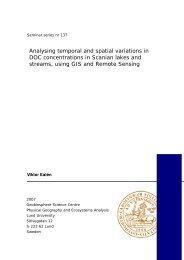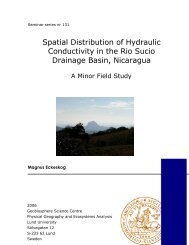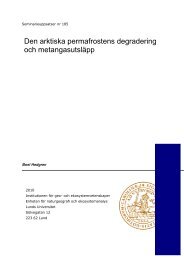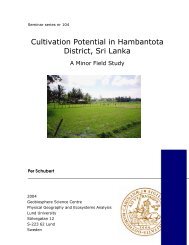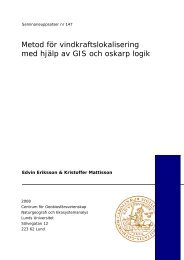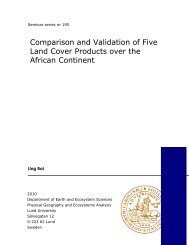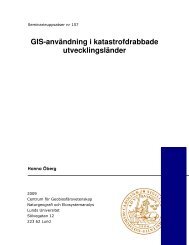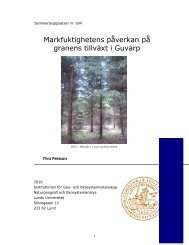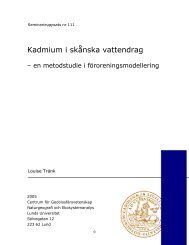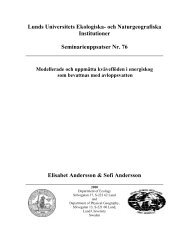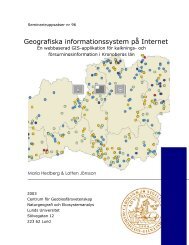Finding Potential Sites for Small-Scale Hydro Power in Uganda: a ...
Finding Potential Sites for Small-Scale Hydro Power in Uganda: a ...
Finding Potential Sites for Small-Scale Hydro Power in Uganda: a ...
Create successful ePaper yourself
Turn your PDF publications into a flip-book with our unique Google optimized e-Paper software.
From this we can draw the conclusion that the quality of watercourses as <strong>in</strong>put data is ofmajor importance. As the result from the evaluation show, almost 80 percent of the sitesdo not qualify to be a potential site <strong>for</strong> small-scale hydropower, because of low quality of<strong>in</strong>put data. There are two different errors that can contribute to the low quality of data.The first and most obvious is the classification error mentioned above, but also theaccuracy that the watercourses have been digitalized with can be of importance. If thewatercourses have been imprecisely digitized, this can result <strong>in</strong> rivers located at thewrong position <strong>in</strong> the DEM, when mak<strong>in</strong>g the overlay. This can result <strong>in</strong> loss of potentialsites or ga<strong>in</strong> of false sites.6.6 Lesson LearnedFrom our study we conclude that the result is largely dependent on the quality ofwatercourse <strong>in</strong>put data. In order to avoid errors such as <strong>in</strong>correct classification and lowdigitalization precision and to receive a more accurate result, one option is to use self-<strong>in</strong>put data over rivers and streams. This can be atta<strong>in</strong>ed by us<strong>in</strong>g the producedproducedDEM to calculate catchment area and flow accumulation. To make the <strong>in</strong>put data evenmore reliable, factors concern<strong>in</strong>g precipitation, <strong>in</strong>filtration and evaporation can be taken<strong>in</strong>to consideration. This is an extensive task, which demands a thorough <strong>in</strong>vestigation ofthe geology and climatology of the area. Although this is time consum<strong>in</strong>g, the resultshould be rivers at exact position and also knowledge about its volume flow rate andtemporal variation. A better, faster and more reliable approach would be to use ourmethod with available watercourse data and per<strong>for</strong>m a field survey <strong>in</strong> the area of <strong>in</strong>terest<strong>in</strong> order to ensure which sites that really have a potential <strong>for</strong> small-scale hydropower.6.7 End DiscussionAs mentioned, there were only three sites <strong>in</strong> the evaluation that fulfilled the criteria of asuitable small-scale hydropower site. To put these <strong>in</strong>to context, the site with smallestpotential electrical output of 1.9 kW would accord<strong>in</strong>g to Fraenkel et al. (1991) be suitable<strong>for</strong> a battery charg<strong>in</strong>g station, as it is not economic to transmit electricity over longerdistances because the cost of the cables will be out of proportion to the value of thepower. Further Maher and Smith (2001) argues that a small-scale hydropower stationwith a potential electrical output equal to the site <strong>in</strong> Nyambare (4.8 kW) is enough tosupply a village of up to 100 households with common devices such as; light bulbs,radios, televisions, refrigerators and food processors. The largest potential site found <strong>in</strong>the evaluation, with a capacity of 48.4 kW, would be suitable <strong>for</strong> <strong>in</strong>come generat<strong>in</strong>gbus<strong>in</strong>esses, such as small-scale <strong>in</strong>dustries or workshops as well as <strong>for</strong> household energy.63



